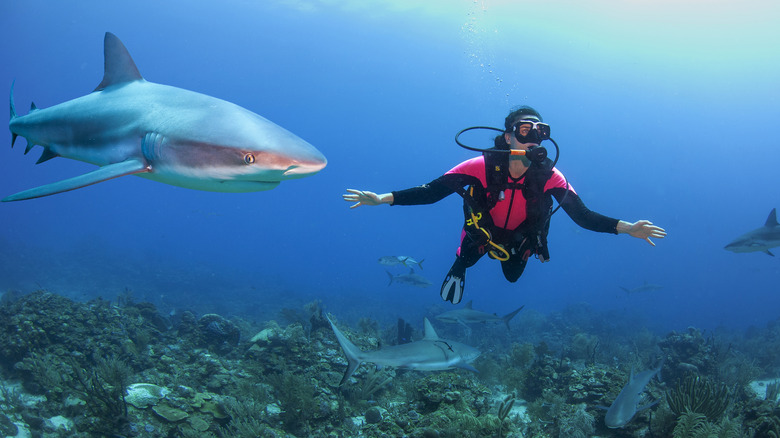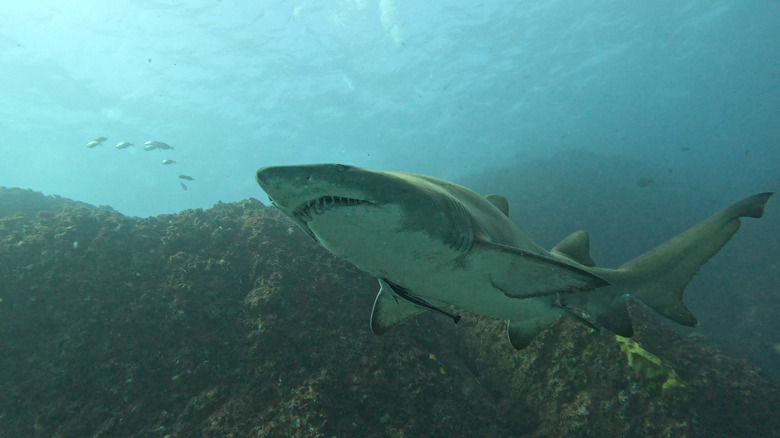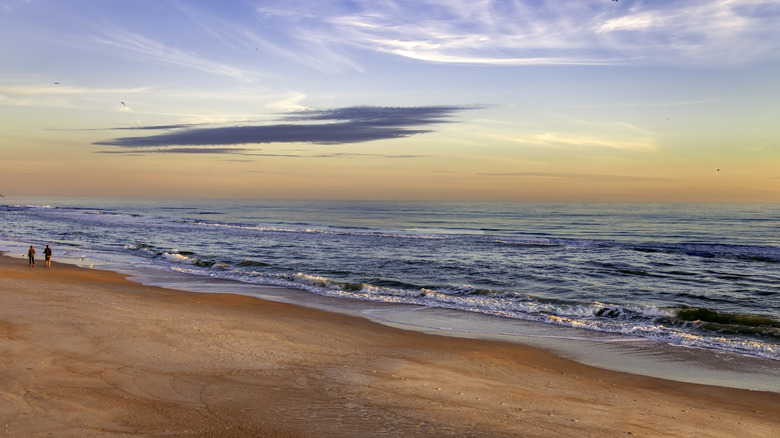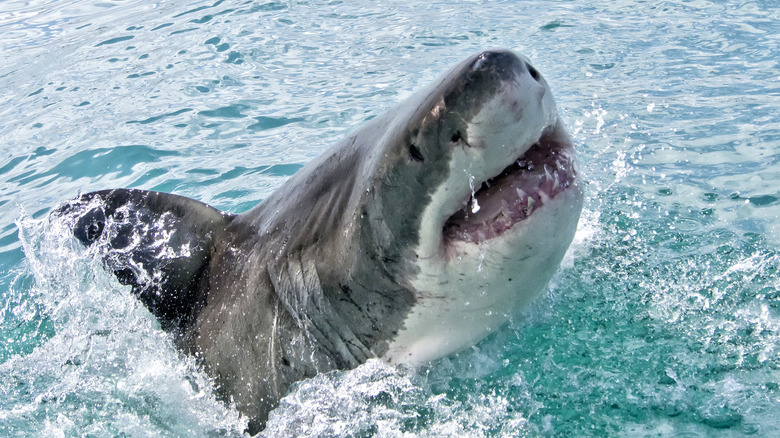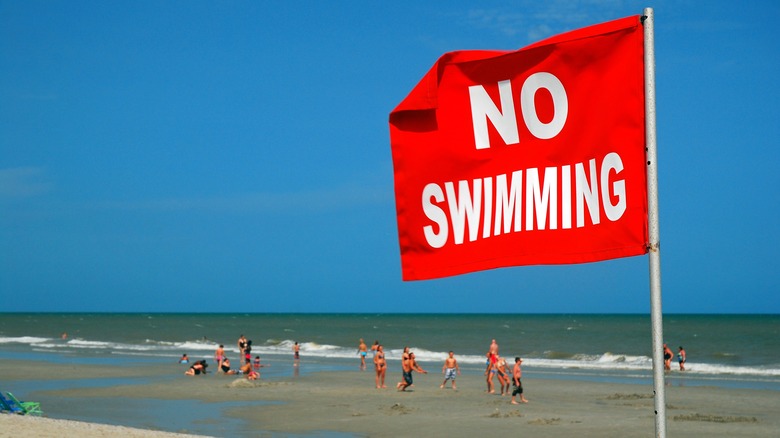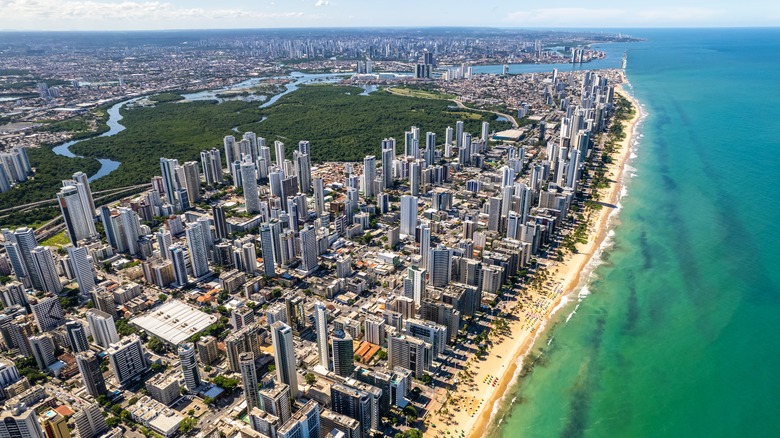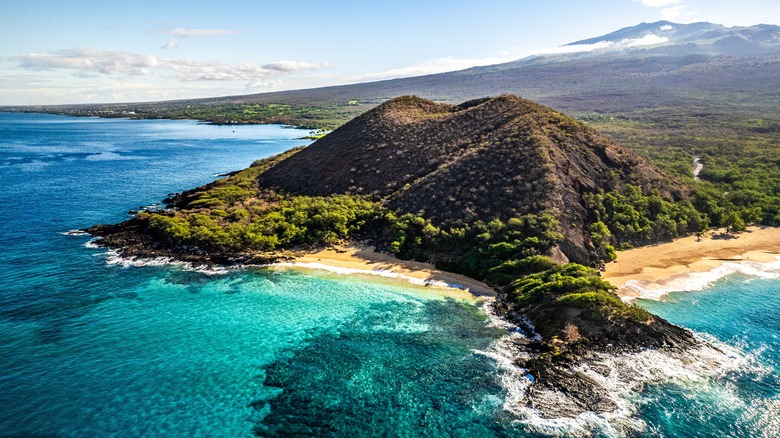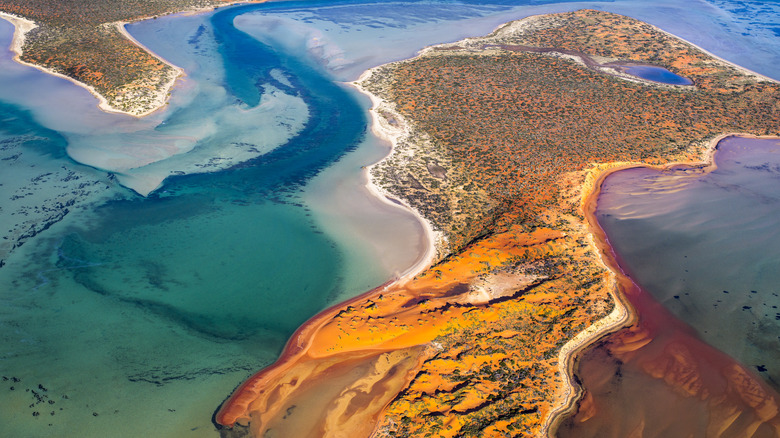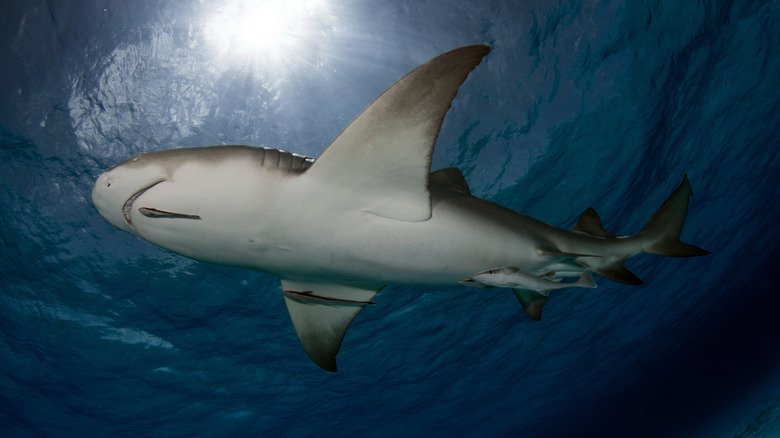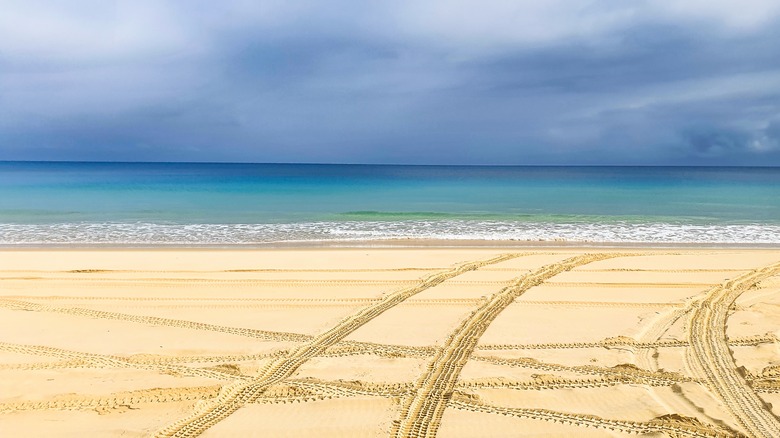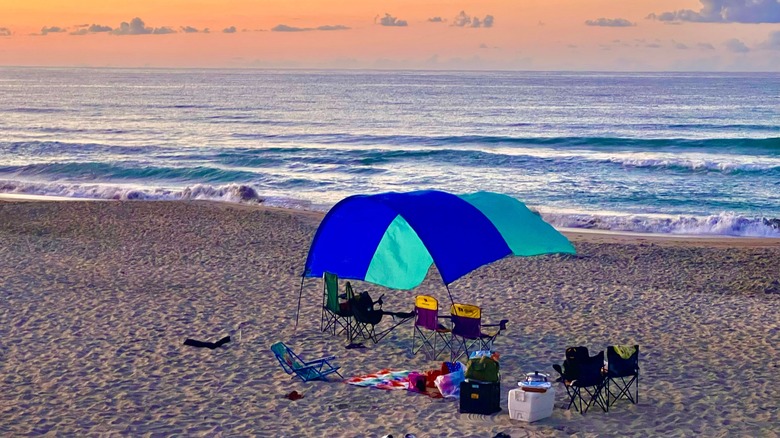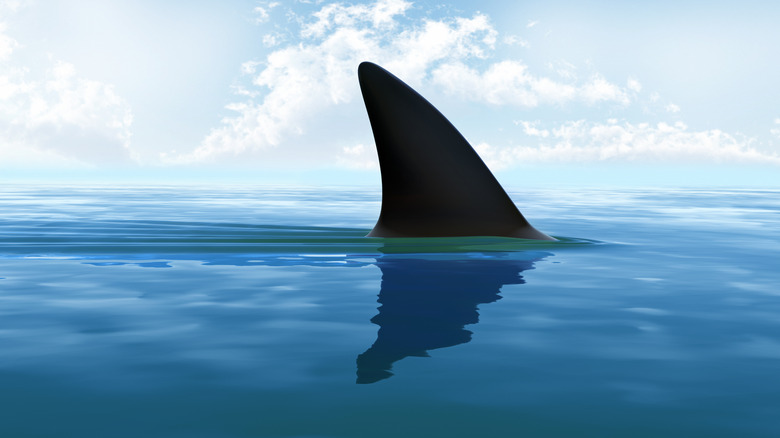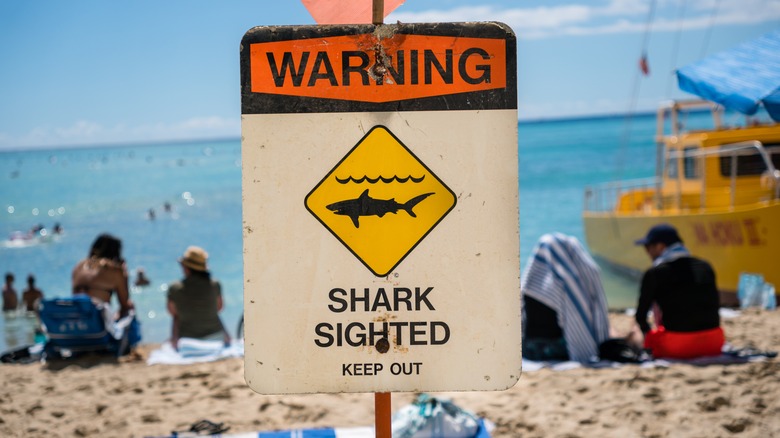The Most Dangerous Shark-Infested Beaches In The World
Nothing ruins a relaxing day at the beach faster than hearing the word "shark" enter the conversation. However, the reality is that every time you step a toe in the ocean, you're entering the shark's domain, and the possibility of encountering one of them is present. In 2023, the amount of unprovoked attacks saw a slight uptick, with the number of deaths from shark bites doubling compared to 2022, according to The University of Florida's International Shark Attack File (ISAF). "This is within the range of the normal number of bites, though the fatalities are a bit unnerving this year," explained Gavin Naylor, director of the Florida Museum of Natural History's shark research program.
In 2024, 12 shark attacks had reportedly occurred in the United States alone less than halfway through the year (via El País). The thing is that many of these shark encounters are concentrated around specific beaches that attract these sea creatures for one reason or another. With that in mind, you may want to avoid planning your vacation at one of these extremely shark-infested beaches around the world.
Byron Bay - Australia
There are several different threats lurking in the waters of Byron Bay. One of the most worrisome is the fact that this beach sees plenty of shark attacks, with 16% of all the attacks in Australia occurring around this area, according to Macquarie University. Even though it's a very popular vacation spot that brings in more than 2 million visitors annually, many tourists don't realize how close they are to sharks here. In 2021, a drone captured footage of a shark swimming only a few feet away from a bunch of people in the water enjoying their day, seemingly without a care in the world.
A couple of years earlier, a man was attacked by a shark at Byron Bay in the early morning hours when he was surfing. He was airlifted to a hospital with severe leg injuries. Thankfully, he ended up in stable condition, but it was a close call.
Byron Bay is so deadly that a sign at the entrance of the beach warns visitors of all the possible dangers waiting in the waters. Besides the sharks, this beach also has strong rip currents and sudden drop-offs. All these things can make Byron Bay very unsafe for young children or poor swimmers.
New Smyrna Beach - Florida, United States
This dangerous Florida beach also has strong rip currents and is located in a county that Business Insider calls "the shark bite capital of the world." Florida as a whole is the biggest hotspot on the planet for shark attacks, with 259 non-fatal shark bites occurring in the state between 2012 and 2021, per the ISAF. Thirty-two of those attacks occurred on New Smyrna Beach, which is twice the amount of any other beach in the United States, according to a study by Travel Lens.
The sharks aren't necessarily intentionally targeting humans. Rather, they get confused in the beach's murky waters. As one beach safety officer explained to WESH 2, "The bites here are a case of mistaken identity. It's usually a bite-and-release type deal. The shark realizes what it's bitten into and then they don't like the way we taste." However, all it takes is one bite to get hurt.
In 2023, a shark chomped a surfer's face at New Smyrna Beach, and the man received a 2-inch cut on his cheek. Most recently (on July 4, 2024), a man in his early 20s had his right foot attacked by a shark while he was playing football in the shallows of New Smyrna Beach. Thankfully, he walked away from the incident with survivable injuries after being treated. These stories and statistics should definitely make you think twice about getting in the water at this shark-infested beach.
Gansbaai - South Africa
The beaches around Gansbaai in South Africa have so many sharks that the area has become a booming tourist attraction. This coastline has one of the largest populations of great white sharks, which are one of the species most likely to injure humans, according to the U.K.'s Natural History Museum. A study published by the European Zoological Journal sought to figure out how many of these sharks lived around Gansbaai. Researchers spent a little over a year monitoring the waters, and during that time, they spotted 423 great white sharks. That's no small number for such a rare sea creature.
According to the World Wildlife Fund, the number of great whites left around the world is declining. Gansbaai could be your best chance of seeing one of these sharks in the wild waters with your own eyes. The shark sighting season in this region occurs from June to September, as the water is clear and the animals are migrating, and there are many highly-rated tour companies that bring visitors to the ocean to go cage-diving with the great white sharks around Gansbaai.
However, these are still wild animals, and dangerous incidents can happen. In 2015, a honeymooning couple went cage-diving in Gansbaai's 'Shark Alley' channel when they captured a video of a great white shark attack. Everyone survived, but it may have been a different story without the protective cage.
Myrtle Beach - South Carolina, United States
Visit Myrtle Beach claims that 19 million visitors flock to its beautiful coastal region in South Carolina annually, but do those visitors realize they could be mere feet away from a shark in these waters? A South Carolina marine biologist told The Sun News, "If you're flying over Myrtle Beach, you can see big sharks roaming around. They might even be swimming around people, and you would never know." Imagine all those families being encircled by unseen sharks just beneath the surface.
Summer is the most popular time for a vacation in Myrtle Beach, and it's also when thousands of sharks make their way through the area. Some of these shark species are considered harmless to humans, such as lemon, spinner, and hammerhead sharks. However, more aggressive species also frequent Myrtle Beach, including black tip, bull, and tiger sharks, which are all known to attack people, seemingly for no reason.
With all these different potentially dangerous species in the waters of Myrtle Beach, it's no surprise humans can encounter sharks on occasion. In 2022, NBC News reported two attacks happening in just one day. First, one swimmer got a bad shark bite on their forearm. One hour later, another person had their leg nipped just half a mile down the beach. The following year, a 56-year-old man ended up in hospital after being bitten by a shark at Myrtle Beach.
Boa Viagem Beach - Brazil
Boa Viagem is an absolutely breathtaking Brazilian beach with a deadly secret — it is notorious across South America for having an exceptionally high rate of shark encounters. One user on Tripadvisor said that they would never let their family go swimming at this beach and that there are warnings all over the shore urging others to do the same. In Boa Viagem, be careful.
The strange thing about this particular shark-infested beach is that it wasn't always this way. In fact, before the 1990s, there were rarely any shark attacks on Boa Viagem Beach, but then something turned. After 1992, suddenly people were getting bitten regularly. Soon, there were 47 attacks on the beach in less than a decade — 16 of them fatal (via BBC News).
According to the BBC, sharks started hunting closer to Boa Viagem Beach after construction of the city's port in the 1990s disturbed the spots where they usually eat and reproduce. The boats at the port dumped more pollution into the waters, drawing in the sharks to feed. As the president of the Brazilian Society for Elasmobranchology Research told BBC, "Sharks are actually drawn towards polluted water. They are expert hunters but they're not above scavenging through the sewage for a meal." While visitors are still technically allowed to swim at Boa Viagem, it's heavily advised to stay out of the water.
Makena Beach - Hawaii, United States
Even though this gorgeous U.S. state sits atop of o many traveler's bucket lists, Hawaii can be a surprisingly risky destination to visit. The presence of sharks is a big reason why beaches in Hawaii are considered some of the world's most dangerous. Even though Makena Beach upholds Hawaii's reputation for having stunning beaches, you should probably just appreciate its beauty from the shore — it also has a huge shark population.
Many tiger sharks — one of the most aggressive species towards humans — are active around Makena Beach, and they like to hunt in the shallow part of the water where swimmers hang out. Unfortunately, that means that many of the attacks on this beach end up being fatal. In 2013, a man was fishing in a kayak when he was killed by a shark off the coast of Makena Beach. A couple of years later, the body of a woman was found by snorkelers with signs of being killed by a shark.
These days, Makena Beach takes shark safety very seriously. In 2022, officials shut down Makena Beach (and all the nearby beaches) after a large tiger shark was seen swimming around the area. That could explain why there has been a decrease in attacks in recent years. Even so, shark attacks at Makena Beach remain a serious concern.
Shark Bay - Australia
With a name like Shark Bay, it should come as no surprise that this coastal area of Australia is home to a huge population of the fearsome sea creatures. The beach was named by explorer William Dampier in 1699, who observed that sharks were the main type of fish he saw swimming around these waters. Since then, many sharks still stick around the bay.
This area has a very diverse marine life population. There are at least 28 known types of sharks living around Shark Bay (via Shark Bay World Heritage Discovery and Visitor Center). It's actually an extraordinary environment because it houses several endangered species besides sharks, including dugongs and loggerhead turtles.
While it is heartening to hear that there is a place with so many coexisting animals in harmony, the abundance of sharks can create some issues for humans hoping to get in the water. Shark sightings do happen, and while attacks are extremely rare, you still have to be very careful. In 2022, an Australian man told the Daily Mail he was checking Shark Bay's water with his foot to make sure nothing was hiding beneath the surface before letting his kids swim. As he did, a tiger shark came out of nowhere and tried to attack. Safe to say, the family skipped the swim that day.
West End - The Bahamas
From a distance, the West End in the Bahamas looks like the type of majestic coastal destination perfect for recharging on vacation. The waters are crystal clear, and the beaches are covered in soft, white sand. Paradise, right? However, there are so many sharks around the West End that it makes all that natural beauty less alluring. It's believed to be one of the most shark-infested beaches in the Caribbean. Paradise potentially comes at a price.
The most common type of shark in the waters of West End is tiger sharks. As mentioned, this can be a problem for swimmers because this species is especially aggressive and attacks humans more than any other except great whites, according to Ocean Conservancy. While shark attacks are actually quite rare in the Bahamas, they can be deadly when they do happen.
In 2023, a German woman was participating in a diving expedition around the West End to try and spot sharks in the water. The next time onlookers saw her, she had breached the surface and appeared to be fighting for her life against a shark. A rescue team tried to save her, but she disappeared completely, and only her diving equipment was recovered.
Fraser Island - Australia
Australia's Fraser Island has miles of dreamy beaches that would entice any traveler. Unfortunately, it also happens to be one of the most dangerous islands in the world. Not only are there extremely strong rip tides that can pull you away from the shore in the blink of an eye, but there are also an unsettling amount of great white sharks around Fraser Island.
In 2023, a group of whale watchers off the coast of Fraser Island saw firsthand how many sharks patrol these waters when they came across hundreds of them on their tour. One of the tourists captured drone footage to show just how many were there. The visitor who recorded the video told Yahoo News Australia, "There were, I think, about 200 sharks in the area chasing a huge ball of fish."
If the sharks aren't enough to scare you away, Fraser Island also has large populations of jellyfish, saltwater crocodiles, and even wild dingoes that can be hostile. Additionally, it's an extremely remote location, and no lifeguards are on duty at the beaches. This means that if you do get injured in a shark attack, it can be an even bigger problem at Fraser Island than it would be anywhere else.
Emerald Isle Beach - North Carolina, United States
The number of people around Emerald Isle Beach in North Carolina increases during the summer because it's such a fun place to spend your vacation. However, the shark population also increases right around the same time. Sharks swim through the waters of Emerald Isle to migrate, meaning there are a bunch of them lurking around in the warmer months of summer.
North and South Carolina have some of the most shark-infested beaches in the world due to their location near these migration routes. With that in mind, it's no shock that a number of shark encounters have happened around Emerald Isle Beach. Just a couple of years ago, a video went viral locally of a 5-foot shark aggressively feeding in the shallows of the beach, alarmingly right near where families would likely hang out in the water.
In another incident, a man was surfing at Emerald Isle at sunset (also known as shark dinner time) when he was bitten on his foot and knee by a shark. The surfer said that the shark chased him down like something out of a film, but he somehow managed to escape. "Next thing you know, I felt a stinging feeling. I gave him a good shot right to the nose and automatically he let go. That's how I think I saved myself," he recalled to ABC News 12.
Cocoa Beach - Florida, United States
Florida has more shark attacks than anywhere else in the world, and there is a chance of seeing one of these big fish at any of its beaches. However, there is an even higher chance of spotting a dorsal fin poking out of the water at Cocoa Beach. This beach is on the eastern side of the state, where many of the most shark-infested sections of the ocean are located, according to the Florida Museum International Shark Attack File.
A study conducted by Travel Lens found that Cocoa Beach was the second deadliest beach in the United States, second only to New Smyrna Beach, 60 miles up the coast. The study explained that the beach earned this title due to the high number of fatal shark attacks here. Since 2010, seven shark attacks on this beach have resulted in death.
Historically, most of the shark attacks on Cocoa Beach are unprovoked. One woman told Florida Today that she was hanging on her surfboard when, all of a sudden, she was bitten by a 6-foot bull shark in 2020. She only sustained a foot injury, but she required surgery and physical therapy. Still, Cocoa Beach remains one of the most popular beaches in the region for surfing and swimming.
Surf Beach - California, United States
California is practically synonymous with surf culture. According to the Statista Research Department, there are over 400 places to surf in the state, more than anywhere else in the country. However, the eerie reality is that this hobby increases your chances of coming across a shark. While many Californian beaches come with sharks, some of the state's most shark-infested waters are those of Surf Beach.
You don't even have to be in the water to be in danger at this beach. One man was kayaking at Surf Beach in 2014 when a great white shark attacked his boat, and he had to fight for his life in the water. He told the Santa Maria Sun, "If I had landed on the other side of the kayak, it would have been game over."
He managed to narrowly survive the attack. However, some beach-goers aren't as lucky. Since 2008, there have been four serious shark encounters on Surf Beach; two of them were fatal great white shark attacks. While those numbers don't seem exorbitant, the chance of coming across a dangerous shark at Surf Beach is still higher than preferred.
